Tokyo's so faraway
Although I followed GPS to the town center, I found no actual town there.
I'd never had that kind of experience, nor I'd never had loneliness, and
maybe disappointment, like that. I experienced it not only once but several
times.
The huge earthquake on Mar. 11, 2011 and the following tsunami gave catastrophic
damage for 400km range of Pacific coast of east Japan. A year later, I
finally visited the disaster stricken towns in Iwate and Miyagi prefecture,
Japan.
The earthquake left huge mental damage on us, especially the people lives
in east Japan. We Japanese after the disaster is something different from
we used to be. However when I saw the huge scars left by tsunami, I thought
it could becomes a bigger trauma for the local people. Long time ago I
mentioned tragedy and comedy here. Without any doubt this is a tragedy.
However we cannot sob in grief rest of the life. Surviving in this world
is tough. And the world spins for the people alive.
|
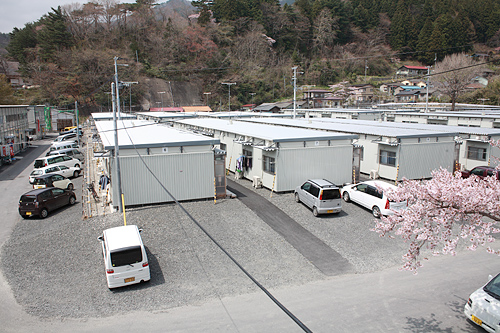
|
"The main reason why the recovery of the disaster area got delay is
uncleaned rubble" I don't remember since when it has been widely picked
up as an issue by media. Japanese government asks cooperation to municipalities
all over Japan for disposing the rubble after the tsunami.
But if you once look at the disaster area, you must have some question
for the government's statement.
First of all "Is it true the recovery got delay?" Magnitude 9.0
earthquake was occurred, and huge tsunami suddenly hit towns and destroyed
everything. How can they recover in one year? I didn't think all the recovery
got delay. But I saw a gap between quickly treated part and the part getting
extreme delay.
The quickly recovered part might be road and temporary housing construction
and sweeping off the rubble. I'm pretty sure the people who actually visited
there would never say the rubble disposal is the biggest issue before reconstruct
a town and a community.
Furthermore, they'll never say to distribute the rubble to municipalities
which far away from the tsunami area by hundreds of over loaded trucks
is a good idea. Even a city in Okinawa rose their hand to accept it. Shipping
the rubble to Okinawa Islands? Is it ties of friendship? Who will get a
benefit with it?
|
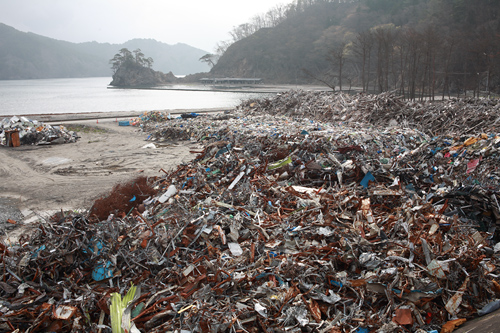
If you step into the disaster area, you must be astounded by heaps of rubble.
However it's quite easy to understand when you image the tsunami washed
off whole town. The rubble smelled like wet mold. I could smell it almost
every town in the area. It's true.
But when we get the information from Japanese government or media, we misunderstand
as if the rubble covers all over the town and that's the main reason of
dull recovery. However as a matter, the rubble are cleaned and heaped up
in the certain block in the town or beach.
So why everybody says the rubble disposal is the most important issue to
support the victim? I think it is influenced by strong image of media coverage.
The picture of rubble or heavily damaged houses certainly gives a strong
impression to the audience. Of course, as long as picturing the truth,
it's not wrong how they crop an image from the scene. But at least, the
media has responsibility for adding some description with articles or comments
to support it. Otherwise people may misunderstand what the most important
issue is. Generally, symbol and facts are different matters.
On the other hand, after the prime minister's nation wide rubble distribution
request, some local governor visit the disaster area. So why they assure
accepting rubble is a top priority to support the disaster victims nevertheless
it's already cleared up. It comes from Japan's top-down systems. All municipalities
just follow the Tokyo without thinking by themselves.
When they visited the area, nothing more than rubble issue is in their
mind. So they ask the local governor. "How's the rubble?" Off
course, the local governor may not answer "It's OK. Don't worry about
it" After all, rubble disposal becomes a first priority to reconstruct
people's life and community.
The rubble disposal argument is also include issue of radioactive contamination
of the Fukushima. The rubble has possibility of the contamination. Some
people say "It's clean. Why not?" The others protest "Don't
accept dangerous materials"
Well, "The distribution itself is quite nonsense" That's my opinion. |

May be you should know the fact around the rubble heaps is acres of vacant
lot. As looking over a distant, you can see a breakwater and a water gate
of river mouth which the tsunami came over. It looks like a devil's opened
mouth. The seawall is still broken and many sandbags are piled up as a
bank. The water gate has not fixed yet. Looks so defenseless. If tsunami
occur once again ... although many reconstruction workers and volunteers
are working in the area. Isn't it an agent issue?
The second priority must be reconstruction of the towns. Nevertheless rubble
is swept off, there is no sign to reconstruct a town. In most of the towns,
foundations of house are just left in the vacant lot as if abandoned ancient
city. In the vacant lot, some coin laundries, gas stations and small shopping
complexes run the business in temporary housing.
"Why there is no sign for reconstruction?" I thought about it.
Maybe there is no blueprint how the residents reconstruct the town.
"Reconstructing a town on the elevated ground" the government
said easily. However I don't think it gets agreement by the residents.
An old man told me. "Living on the hill must be safer. But it's too
much inconvenient for us old" If the government suggest the towns
must remove to the elevated ground for security, most of the big cities
along the coast line of this island country must be subject to remove.
|
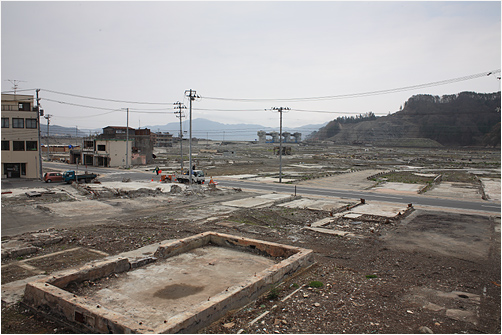
After all, the residents have to make a decision by themselves. Moving to the elevated ground is not only solution. There is another choice, rebuilding a new town which based on well evacuation system in emergency, for example. Constructing a broad road leading people to a higher ground or settling mega floats, although I don't have exact idea. Of course "We don't need a town any more" is another possible choice. They must think about recovery of farmland and fishery too.
The reconstruction plan must be well discussed between specialists and
residents as soon as possible. Without it, the residents won't live peacefully.
Who wants build new houses or shops in the town which doesn't have any
future plan. This unclear future plan situation is a very reason of the
delay in recovery.
But nevertheless they get a blue print for reconstruction, it must be a
long way to the goal. For instance, in case of Higashi Matsushima City
in Miyagi prefecture, some part of the houses are remained fortunately.
On the wall of the houses you can read the sprayed words "Don't demolish"
It means the residents have intention to come back. So in that kind of
area, it cannot be planed new city from zero. However they cannot reconstruct
it as a city used be. It means they never learn from the disaster. That's
in a Catch-22 situation.
On the other hand, most of the towns in disaster area are completely destroyed.
But all the lands are personal properties. So it's necessary to discuss
about land rights for reconstruction. Maybe some of the owners passed away. |
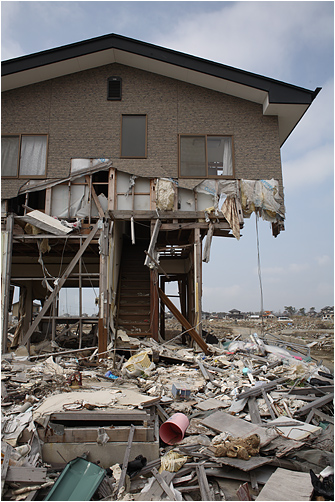
Children forced to change the school. Community members were separated
away in the temporary housing. But the victims try to get back their usual
life.
The thing which can wiped off their grief isn't words for sorry, cheering
them up, nor giving money. It's getting new job and new place for restarting
their usual life. Unfortunately Japanese politics is based on former notion.
I remember, just after the earthquake, I was asked by some friends abroad. "Do you know how our donation will be used effectively for the people in disaster?" Now I want believe it has been done in right way. |
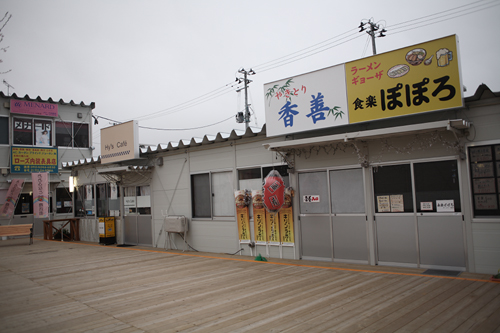
It's just four day visiting to the area. However I got know real matters
which is out of media coverage. And one more thing I knew is this fact"Tokyo's
so faraway"
May 2012
Today's Photos
”Student hall of elementary school” Toni, Kamaishi C. Iwate Pref. Japan
2012
”Cherry blossoms by the temporary housing” Kamaishi C. Iwate Pref. Japan
2012
”Heaps of rubble on the beach” Toni, Kamaishi C. Iwate Pref. Japan 2012
”Broken seawall” Minami-Sanriku Town, Miyagi Pref. Japan 2012
”Water gate and disappeared community” Otsuchi Town, Iwate Pref. Japan
2012
”Half broken house” Higashi- Matsushima C. Miyagi Pref. 2012
”Ofunato Dream Shopping Complex's morning” Ofunato C. Iwate Pref. 2012
”High school students” Kesennuma C. Miyagi Pref. 2012 |
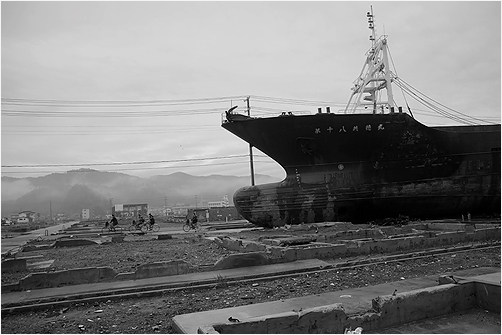
fumikatz osada photographie
|






